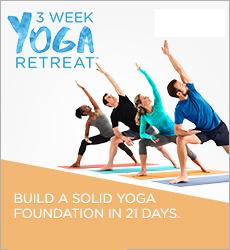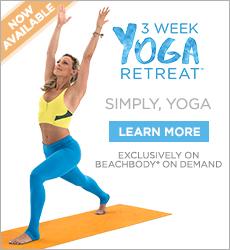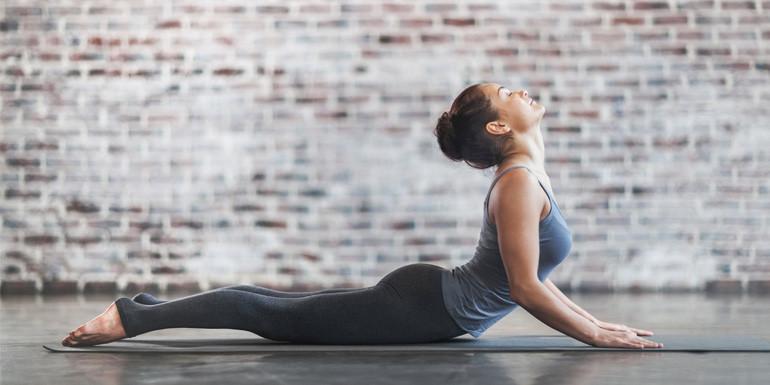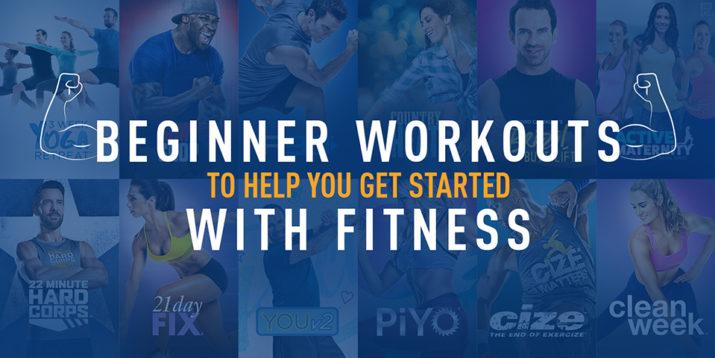39 Yoga Tips for Beginners
39 Yoga Tips for Beginners
 Yoga is no joke and even those who have been doing it for years admit how it can be daunting a practice. And so, if you are one of those who have bravely decided to take on the challenge, then it is important to arm yourself with the right knowledge to see it through. Imagine yourself finally joining a yoga class for the first time and how confident you can be instead of feeling shy or afraid to do it. You can avoid the common mistakes beginners make due to lack of preparation. These pointers are certainly going to help you enjoy every yoga session you attend while maximizing the benefits the practice can give you.
Yoga is no joke and even those who have been doing it for years admit how it can be daunting a practice. And so, if you are one of those who have bravely decided to take on the challenge, then it is important to arm yourself with the right knowledge to see it through. Imagine yourself finally joining a yoga class for the first time and how confident you can be instead of feeling shy or afraid to do it. You can avoid the common mistakes beginners make due to lack of preparation. These pointers are certainly going to help you enjoy every yoga session you attend while maximizing the benefits the practice can give you.
1. Meditate with intent
Yoga won’t be complete without meditation so start your practice with one. Sit in your most comfortable position or do an easy pose and get into meditation mode for a few minutes. This will help you to focus as well as begin with your purpose in mind based on whatever goals you may have for your practice.
2. Learn how to breathe properly
Proper breathing is one of the most essential things that you have to learn in yoga to be able to execute and hold the various poses. It is important to breathe in and breathe out from the nose then into the belly. One of the basics is the Dirga pranayama breath.
3. Practice from within
When you are new at something, it seems easier to just look at how others or how your teacher would do it. However, this may result to you getting awkward with your poses or not doing it properly. So feel your body and practice yoga from within because it is really an intimate encounter with yourself. Deepen your self-awareness and let yoga build you from within.
4. Safety first
Yoga does not discriminate and anybody at any age can benefit from it. However, you must make sure that you are safe to practice it before you proceed. In general, you have to be free from any injury or ailment that might complicate it if you make it a part of your routine. In this case, a medical clearance from your healthcare professional must be sought. There are also contraindications specific to a posture that you have to pay attention to. The most common ones are high blood pressure, pregnancy, menstruation, and injuries in your neck, shoulders, and knees.
5. Keep a practice journal
You will learn a lot of things along the way and you might want to take down notes so you can come back to them at any time. Record your realizations, insights, observations, thoughts, new terms learned, curious questions and a list of postures that you already know or the ones that you need to work on.
6. Practice at home
Establishing a home practice gives you numerous advantages. It lets you practice at your own pace and at your most convenient time. It also makes you comfortable outside of the yoga “classroom” so you can adjust to any environment when you need to travel or stay some place else. Most of the time, classes can be so fast-moving that you will not be able to align your body properly as you try to catch up. This is a habit that you do not want to build so practice at home and be as flawless as you can be when you are back in class.
7. Unleash your creative side
It will help you a lot if you utilize that creative side of you when you start practicing yoga. With all the different poses that you have to go through, making stick drawings or any kind of visual will make you remember them with accuracy and execute them better. They do not have to be amazing works of art but the tip is to make use of visuals like drawings or digital photos to help you master your practice easily.
8. Get a yoga mat
A sticky yoga mat is a must-have for all yoga enthusiasts whether a beginner or not. Choose the one which can provide adequate padding and a non-slip surface. To start, classic yoga mats are good enough but as you go along, you will need a thicker mat. A sticky mat will help you achieve firm footing and stability in your poses.
9. Learn the principles of alignment
The principles of alignment are like the foundations of a building. When the footings are shaky, then it is likely to crash down. The emphasis of yoga and its various styles is in musculoskeletal alignment as this is key to your safety – avoiding injury, as well as your ability to capitalize on the benefits of the asana. So take the alignment principles to heart and build a solid foundation with strong lines.
10. Bring joy into your practice
Like any other seemingly difficult feat, beginning your yoga practice with a smile can really lighten the load and help take you through the challenge. A smile can relax the body as well as your mind, and makes you enjoy the asanas more than anything. When you do it with cheerfulness and calmness, it gives you the extra energy to push your body to the limits and stretch it like it’s the most enjoyable thing in the world.
11. Check out some yoga props
Props are meant to ease your way through yoga when you are just starting – make you feel comfortable as you work on improving your alignment. Yoga blocks help stabilize your standing poses. Yoga straps allow you to stretch further when you are doing seated poses or bound poses. Bolsters or blankets facilitate restorative poses. You can choose to get them for home practice but in the yoga studios, they have stacks of these props for use during classes.
12. Include relaxation with your postures
You will find that your typical yoga class will emphasize heavily on the asana practice and the relaxation aspect would sometimes take a backseat. As a newbie however, it is important that you take time to relax, meditate, recover, and feel better. This will help you achieve that essential balance between physical health and mental well-being.
13. Don’t forget to warm up
Before you hit your mat, remember to warm up. Gentle exercises such as the Sukshma Vyayam will loosen you up and prepare you for the asanas up ahead. You can give your cheeks, nose, brows, and head a good massage. Then, turn your neck clockwise and counterclockwise to relieve stiffness. Finally, pump those shoulders and shake your hands off to wake up the body.
14. Take it step by step but go beyond your limits
Yoga is a pretty dynamic practice and the best thing about it is that it gives you plenty of room to improve and reach your highest potential. So yes, you do what is comfortable for you but as you become more confident, you can opt to stretch a bit further and challenge your limitations. You will know when your body is still okay with what you are doing when your breathing remains light, long, and relaxed. However, when it starts getting uneven, then you might have over-exerted already, so just slowly tone down your pace. In any way, make your practice as challenging as you can because there’s still a good number of yoga asanas you can explore.
15. Allow a qualified instructor to guide you
Certainly, you are not going to proceed without a qualified teacher to lead you to the right path. Your teacher will guide in doing each technique correctly, learn the postures properly, and be from injuries along the way. Keep an open mind because those yoga philosophies will not only enhance your experience, but improve the way you live your life as a whole.
16. Kickoff with beginners level postures
It is but right that you start with the basic postures first so you can build a solid foundation and climb your way up with confidence. Do not attempt any yoga pose because it looks complicated and doing it will make you look impressive. Begin with some warm-up sequences and proceed with simple postures such as a forward bend, seated twist, triangle, cat, mountain, dog, cobra, child, and downward-facing dog. Once you are well-adjusted with these poses, then you earn the right to get into the advanced level.
17. Let it do its work
In the process of you getting to know yoga, you might reach that point where you will want to do it your way or feel like doing something else. While this is a natural tendency, it would be best not to give in and just allow the practice to do its work on you. Instead of trying too hard, try to let the posture, breathing exercise, or meditation, work as it is because it will allow you to receive maximal benefits this way.
18. Inform your instructor
If there is anything that is restricted of you due to a medical condition, inform your teacher about it before the yoga class begins. In this manner, he or she can take note of the things that you can and cannot do. It would be easy for him or her to customize your practice with consideration on your safety.
19. Don’t eat or drink before your practice
Considering the poses you have to do during a yoga session, you are advised not to eat or drink beforehand. This is especially true when the session will include practicing inversions. So make it a habit to eat way before your class starts at around 1-3 hours before, and drink small amounts of liquid only. During the practice, it is advisable to refrain from drinking water.
20. Gear up
What to wear on your first day? The principle to yoga clothing is to wear something loose or comfortable so as not to restrict movement or make you feel too shy to stretch out when some body parts get exposed with your movements. Stretchable clothing is recommended in this case and you can check out dozens of manufacturers that specialize in yoga-suited clothes. You can also opt for what you already have in your closet that’s great for any exercise such as unitards or tights.
21. Create a yoga corner in your home
For your home practice, it is highly suggested that you allot a special area just for your yoga sessions. In this way, it will motivate you during those times when feel sluggish or lazy. Put your mat in there, together with some props in one place, and probably some inspiring posters – anything to make the area look serene and inviting enough for you, right in the comforts of your home.
22. Try stepping back
If you are one of those who would typically sit in front of your academic class, try a different strategy in your yoga class. Step backwards, go to the back of the room, and be a good observer instead of an active, competitive, front-row student. You might find that moving away from where the action is will help you focus and internalize the practice better.
23. Choose doable postures
You would want to take it easy while you are just starting so it would be good to choose postures that seem doable at first glance. With this, you can go for floor-bound postures first over standing postures that will require greater strength or balance from you. Also do postures that have longer hold times in terms of breaths because it would mean that they would be easier to execute.
24. Don’t hesitate to ask
The perfect time to unleash your inquisitive tendencies is during your yoga classes. Don’t be shy to ask questions especially when something is not clear to you. Your yoga teacher is sure to welcome them and not consider it a distraction. Direct questions about specific postures to your instructor. Meanwhile, the whole class would be more than willing to chip in their own insights as more experienced students. Otherwise, you may ask questions after the yoga session.
25. Be early to bed
You will notice later on that yoga enthusiasts would typically sleep on time or early because they want to meditate and enjoy a long asana to help them start the day. It might take giving up or toning down on some of those late-night actions that you are used but it will be worth it. So if you are not a morning person, give yourself time to adjust and allow the practice to do its wonders on you.
26. Focus on yourself
In a class of 15 or so, it would be easy to get a bit jealous with how others seem to be able to do it competently and confidently. You can get lost in how your classmates in the yoga class execute poses like its nothing. However, it would be more beneficial for you to focus on your own pacing and development rather than comparing yourself to others. Remember that you are as unique as every yoga asana there is. No need to feel pressured when you are not as fast or as good especially when you are just beginning your journey. Focus on yourself and one day, you will be surprised at how good you have become.
27. Check your pain tolerance
It is expected that you will feel some some soreness in the first few days of your practice especially in the muscles. This is something you need not get alarmed about and as the days go by, your body will be able to adjust and not feel that much pain anymore. As long as you keep to your practice and make it an important part of your routine, then your body will get used to it. However, if it is that kind of pain that persists, it is time to let your instructor know about it so together you can determine if it is something else and you need to do something about it.
28. Never give up
Preferably, yoga asanas are to be practiced in the morning, as early as you can. But if you are not a morning person, then you can definitely choose to do it later in the day. What’s more important is the consistency of your practice, that you never give up until you become a regular yogi – no excuses whatsoever.
29. Select your yoga type
There are tons of yoga classes out there and you need to do some research to pick the one that is just right for you in terms of your pacing, personality, ability to learn, and physical state. Take a look at different yoga styles and get to know them a bit. For beginners, vinyasa or ahatha class is recommended with consideration on whether you prefer it to be fast or slow-paced. This will be good to start and you can simply move on to something more fancy later.
30. Make your practice distinctive
Make your yoga practice a seriously fun business by making distinct definitions. Explore various techniques and pick the ones you would like to focus on. Then, balance it with proper breathing, meditation, and your asana practices. Get into the details such as the order of your routines, the poses you need to prepare for, as well as the methods you’re using. For anything, you can ask your yoga teacher or classmates for help.
31. Make the necessary adjustments
The postures you see in pictures or with your yoga instructor is your goal, or the direction that you are supposed to take. However, these are not strict or inflexible standards because you can actually modify them to fit your bodily dynamics and uniqueness as an individual. So go ahead and experiment on different positions and align them with your body’s mechanics to make them work for you.
32. Gather relevant yoga resources
To have the best practice, you have to have all the knowledge and skills right at your fingertips. You can collect books, videos, audio records, or CDs that will help increase your knowledge base and help you internalize your practice and meditation. Get them from different sources and levels of practice so that you can explore different perspectives. Manual-style, inspirational, or yoga philosophical books are highly recommended together with basic anatomy workbooks.
33. Cool down
After an intense yoga workout, take time to cool down with a Yoga Nidra as this is as essential as the workout itself. Sometimes, you can have so much to do in a day, that you would tend to just get up and go immediately after your asana practice. However, you need to cool the body down first so the energy can get consolidated inside of you. Just lie down and savor the Yoga Nidra even for a few minutes, relax your body and mind, and let the energy flow through you. Now, you are recharged and ready to face your big day!
34. Find a yoga class to your liking
Check out resources on the Internet and see what yoga classes are offering in your locality. Your local newspapers or online magazines can direct you to a listing of wellness studios or gyms which conduct regular classes. The one nearest you can be motivating to go to but make sure that you get into a beginner’s level class with a teacher who can understand your needs and is very helpful with your practice.
35. Practice frequently
It is certainly preferable to practice more times in a week even if they are short, than to do it longer and less frequently as it will yield better results. Your practice can be 15-90 minutes each day or at least thrice in a week. You have to make it fit into your schedule as much as you can if you consider it an important aspect of your overall well-being.
36. Learn some Sanskrit
If you are into languages, it would do you great to learn some Sanskrit and be able to sound it off. It is actually an elegant and orderly language and has been used in yoga for thousands of years. Many of the mantras used for meditation is associated with Sanskrit as well so it will help you pronounce the words accurately and maximize its effects.
37. Steady and intense
As a newbie, you can start slowly and gradually work your way up, then increase the level of your intensity. When you are ready, you can take up the challenge and be as vigorous as you can, as long as you already have mastered the alignment of each posture. There are different ways to intensify your practice and one is to hold the postures longer and in longer time periods. Another one is to try more advanced postures or be able to move between varied postures quickly.
38. Keep a positive and open mind set
You are a human being and even in yoga, you can commit mistakes. Try to stay positive when your teacher would give you corrections to your postures. Remember that it is only for your own good and interest that he or she is doing it. This is one of the best ways by which you can learn. Keep a good sense of humor in this beginning stage, smile when you make a mistake, and just enjoy every moment of it.
39. Take a breathing break
It’s not all work as they say so take breathing breaks in between. This is a powerful antidote against stress especially when you make use of them on a regular basis. When you are feeling exhausted or extremely busy, take a moment to count your breaths and relax the tension away – close your eyes if you have to. Do this for at least 5 minutes, twice daily and find yourself feeling recharged by this meditation-like practice.
–If you would like to try some yoga a great place to get started is with our 3 Week Yoga Retreat which can be accessed with Beachbody On Demand. You will also have access to a ton of other yoga workouts and workouts like P90X, P90X2, P90X3, Insanity, T25, Brazil Butt Lift, TurboFire and man many others.–









One Comment